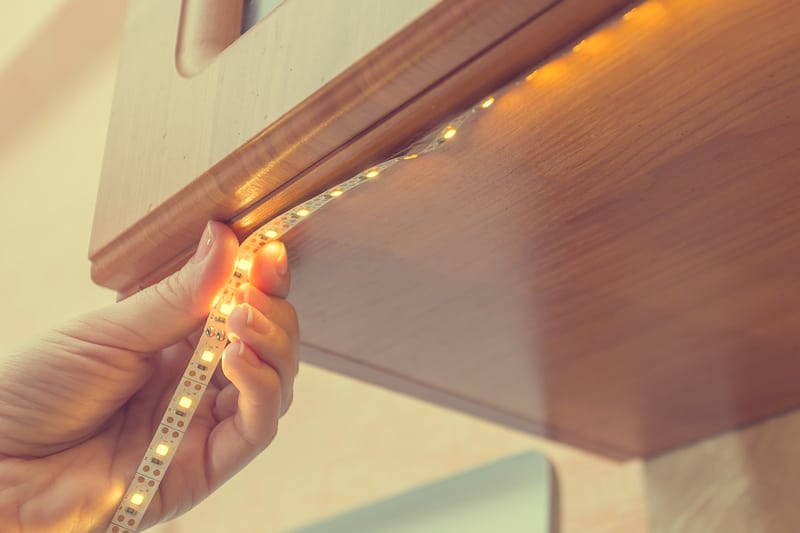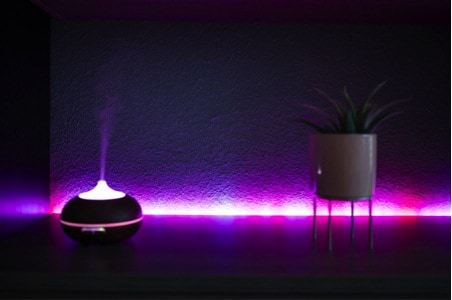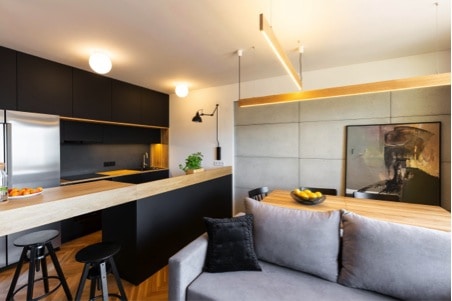If you want to set up your dream lighting, or you’re looking for a light source that gives you a lot of designing freedom, LED strip lights are just what you’ll need. Those inconspicuous LED strips are not only straightforward to set up, but also give you almost limitless options for lighting design. Of course this doesn’t mean you should buy just any LED strip lights you set your eyes upon – they can greatly vary in quality and different types of LED tapes have varying capabilities. Here’s what you should know about them before buying.
What are LED strip lights?
Contents
To put it simple, they are low voltage strip-shaped small circuit boards with (placed in regular intervals) surface-mounted LEDs and adhesive, peel-and-stick backs. Although their depth and length varies, they’re always narrow and quite flexible. This gives them great versatility – they can be easily placed on many surfaces, e.g., plastic, wood or metal, and fit even in awkward spots, e.g., inside wardrobes, under cabinets, along the banisters and stair or between cupboards. Moreover, some LED products are also water-resistant/waterproof which makes them great for outdoor and wet places.
LED strip lighting comes in many colour options – from cool white/warm white light, through red, green and blue, to almost the whole colour palette (you can even find some UV light options). Some models can even be colour-changing. Many strips can also be dimmable. In most cases, LED strip lights come in long reels (typically 5-meter-long, but they can go up to 30 m) but can be easily cut-to-length thanks to their sequential build. The places where it can be cut are marked with a cut line and copper pads.
When it comes to installing, LED light strips come in two categories – plug and play or wired. The plug and play ones are very easy to set up (they don’t require an electrician to be safely installed) and can be moved around. Wired ones are meant for permanent installations and might require electrician’s help in setting them up properly.
To sum things up, LED strip light offers you:
- low energy consumption,
- high flexibility,
- ability to be cut to desired length,
- varied colour options and dimmability,
- possible waterproofing,
- easy installation.
How to determine the brightness of LED strip lighting?
The brightness of LED lights is determined in Lumens (not Watts as some may think). When it comes to strip lighting, its brightness is typically described in Lumens per meter and depends on the density of the strip’s LEDs. A standard density (SD) LED strip has 30 diodes/meter and gives off 540 Lumens/m, while the high density (HD) one will have 60 LEDs per meter and 1080 Lumens/m. You should also remember that a single LED strip light can’t go on forever – the max length for SD one is 10 m and for HD one is 5 m. Why? Longer strips will get dimmer or even flicker as the power won’t be distributed properly between all the diodes.
Why is this important? Different lighting projects require different light intensity, so you’ll have to plan it accordingly. Here are some examples:
- mood or accent lighting – 300-900 Lumens/m,
- under cabinet lighting – 525-1080 Lumens/m,
- task lighting with higher distance from the source – 900-1350 Lumens/m,
- bedroom or cove lighting – 540-1500 Lumens/m.
How to choose the right transformer?
All LED strips are low-voltage and require far less power than traditional incandescent bulbs – currently there are 12 or 24 V DC models available. This means that you’ll have to get a corresponding transformer/power supply to hook them up properly to your AC electrical installation.
While looking for it, you must consider three main factors – size of LED chips, given strip’s length and total wattage.
LED chips used on strips can be either small or large. How to determine which are which? It’s quite simple – small ones will be marked as “3528” (which means they measure 3.5 mm x 2.8 mm), while the large ones have the designation of “5050” (for their 5 mm x 5 mm measures). Why does it matter? The 5050 chips are brighter, hence require more watts/meter than 3528 ones.
With the chips’ size and LED strip’s length, the calculation of total wattage is very simple – you’ll just have to sum it up, based on this info about wattage per meter:
- 60 small LED chips require 5 W/m,
- 60 large LED chips require 15 W/m.
For example, a 5-metre LED strip with 60 small chips equals 25 W. However, make sure to always add another 20% to avoid potential transformer’s overload. Using that previous example, a 25 W strip should have a 30 W transformer. If you plan to plug more than one strip to a single transformer, remember to choose a power supply with enough ‘juice’ to power them all.
What about dimmable LED lights? The strips themselves are dimmable in most cases, but you’ll also need a corresponding transformer. Simply look for one labelled ‘dimmable’ and make sure it’s compatible with your chosen dimmer switch.
How to connect LED strips?
Every segment of LED strip lights must be connected to a DC power supply – be it directly or through other segments (daisy chain). The exact method of connection depends on the types of plugs or wires provided by the strips themselves and on the transformer’s plug (if it has one that is). In many cases, soldering will be a viable, cost-effective solution. If you’re not comfortable with it, consider buying special solderless connectors. Here’s a cheat sheet for connections:
Transformer with a plug:
- connection with strip’s copper pad – requires a female DC adapter and solderless connector (or soldering),
- open wires/solderless connector – female DC adapter,
- strip with a DC receptacle – goes straight in the plug.
Transformer with open wires:
- strip’s copper pad – solder and iron,
- open wires/solderless connector – female and male DC adapters,
- strip with a DC receptacle – needs a male DC adapter.
If you plan on adding a dimmer, remember to connect it between the power supply and the LED strip light. If you plan on using strip splitters to connect multiple strips to one transformer, the right sequence is: transformer, dimmer, splitter.
How to mount LED strips?
As was mentioned before, flexible LED strip lights have adhesive backing that can stick to various surfaces. Unfortunately, they’re not always enough (e.g., on rough surfaces, glossy or oily finishes) and you’ll have to use some additional mounting to hold them in place. A popular and minimally invasive option is adding some extra adhesive 3M tape on the strip’s back. A bit more permanent mounting would be using some mounting clips with a bunch of small screws.
But if you’re looking for a fully permanent (and stylish) solution, aluminium profiles/mounting tracks will be your best bet. They will not only hold your LED light strips in place, but also give your LED lighting design a slick, more ‘finished’ look. Aluminium LED profiles are typically U or V shaped (with special, less obvious variants available) channels that house the strips, shielding them from mechanical damage. Most of the models also include a plastic topping that reduces the glare of the LED lights without obscuring the light itself. They’re also great heat sinks (although LED strip lights and other LED lights generate minimal heat), which makes them ideal for any temperature sensitive surfaces like wood or plywood.
How to determine LED strip’s quality?
Distinguishing between high-quality LED strips lights and their subpar substitutes can be tricky sometimes. Fortunately, there are some indicators that’ll help you with choosing the right ones:
- Quality and composition of circuit board – high levels of electric current require sufficient amounts of copper material to properly travel through each section of the strip. Therefore, you should only pick up LED strips with at least 2 oz (75.6 g) of copper weight. 3 oz (113.4 g) ones are solid and can handle most installations, but if you want to make sure that your voltage won’t drop while dealing with high power, 4 oz (151.2 g) boards are what to aim for.
- Quality and quantity of LEDs – LED emitters directly impact the stability and quality of light output. On that note, you should avoid any LED strips that are supposed to have high power despite having a low number of LEDs. These types of diodes are most probably overdriven, which reduces their lifespan greatly and leads to premature failures.
- Strip’s surface – a clear indicator of higher quality LED strip is the inclusion of an extra coating of white paint. This increases the surface’s reflectivity and ups the overall light output. Strips of lower quality will most likely skip this step, leaving the board’s copper colour exposed. This affects both the brightness and the colour of produced light, especially when the LED strip is put into an aluminium profile.
Not in the mood for checking out all the details and worrying about the quality? You can find high-quality LED strip lights and all the accessories needed to put them up at https://lucasled.ie/led-strip-lights.
LED strip lights – great option for brightening your home
Flexible LED strip lights can be easily fit in almost all places, which makes them great for creating mood or accent lighting, illuminating wardrobes and storerooms or simply putting an interesting spin on brightening the living rooms. This type of lighting is easy to set up, use and maintain, so you won’t have to do anything special to keep it going for a long time. Moreover, the extra features like dimming its brightness, changing its colour or waterproofing can help you transform even the dullest corner into something magnificent. And all this with the additional benefit of low power consumption and lower electricity bills.


